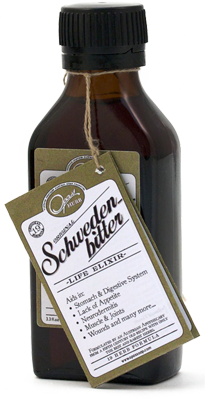Depletion of bitter compounds in the modern diet

Sweet, sour, and salty -- all wonderful traditional tastes we were given. These days our meals include sweet juices, sodas, and sauces. We even have sour and salty plates like vinegar and pickles. In the American diet we have the basic tastes of sweet, sour, salty, and bitter. Other parts of the world have even more tastes including additional; pungent, and astringent. Pungent tastes are spicy and astringent reflects what a persimmon fruit would taste like. Your tastes guide you to proper nutrition.
But wait. What about bitter? What bitter substances do we eat? Salad is bitter especially dandelion. Dandelion salad is eaten happily in the Spring time in parts of France and Germany. But dandelion is limited as it is a seasonal item. Dandelion is not common to find on the menu at restaurants. I've found dandelion in one specialty market along with Whole Foods. Sadly, dandelion is only ending up on a small percentage of our plate. Compared to in the past we had a variety of bitter substances on our plate including; dandelion, arugula, bitter melon, grapefruit, cabbage, kale, angelica root, brussels sprouts, mustard greens, and spinach. How many of these foods have you eaten in this past week?
Bitter substances help us digest food.
Bitter substances are the key to better digestion. They help signal satiety leaving us feeling full and satisfied with our meal. If we do not feel content with our meal we are off to the fridge to look for something else to munch on. This can lead to over eating which can lead to obesity. Bitter compounds stimulate the flow of digestive juices and decrease the appetite. Bitter substances are usually less calories than sugary foods and take up less space in the stomach helping to contract. Sodas, for example, expand the stomach so one may have a feeling to continue eating thus not feeling content with one meal. Bitter foods also help metabolize fat and likely reduce the storage of fat on common problem areas of the hips, stomach and buttocks. Also, through the digestive support of bitter compounds will hinder bloating and flatulence.
Ursel Buehring, a medical practitioner and founder of Freiburg School explained carefully in her presentation the main effects of bitter compounds.
She continued to say
At the presentation it was also explained when bitter substances are taken on a regular basis help improve liver functions, improve metabolism, and reduce cholesterol. The acceleration of food into energy through habit of bitter consumption can result in stimulated kidneys and the blood sugar leveled. Some of the bitter substances, such as glucosinolate sinigrin, suppress the development of precancerous cells.
 If you have a lack of bitter foods in your diet and wonder what the "quick fix" is, sit tight. Schwedenbitter (Swedish Bitter) can offer to aid better digestion and improve liver and kidney functions. Schwedenbitter is very bitter to the taste but can offer well-being just about any where. Various versions of Swedish Bitter on the market today can be confusing but generally Swedish bitter is composed of 11 herbs; angelica root, rhubarb, aloe, manna ash, seen leaf, zedoary root, theriac venetian, camphor, carline thistle, myrrh, and saffron.
If you have a lack of bitter foods in your diet and wonder what the "quick fix" is, sit tight. Schwedenbitter (Swedish Bitter) can offer to aid better digestion and improve liver and kidney functions. Schwedenbitter is very bitter to the taste but can offer well-being just about any where. Various versions of Swedish Bitter on the market today can be confusing but generally Swedish bitter is composed of 11 herbs; angelica root, rhubarb, aloe, manna ash, seen leaf, zedoary root, theriac venetian, camphor, carline thistle, myrrh, and saffron.
Although bitter compounds are recommended to include in your daily diet, Swedish Bitters can be taken regularly as a replacement. In fact, Swedish Bitters are available at your local health or natural foods market. If bitters are not available, please see our original Paracelsus recipe. We are using a 19 herb formula of Swedish Bitter with additional original herbs like Nutmeg which is said to treat indigestion, improve appetite, treat vomiting and toothaches. It also helps prevent gas and fermentation in the intestinal tract.
Other useful ways to use Swedish Bitter include; emotional, mental, and physical stress. Swedish Bitter even has success in elders aiding to refreshen the mind and body. Bitters are especially helpful after prolonged illness.
Spring and Fall detox with Schwedenbitter (Swedish Bitter)
The best seasons to detox are Spring and Fall. Winter fat has accumulated during our heavy holiday feasts which makes March a great time to start a Spring detox. Fall detox helps us to boost our immune systems as infections start to increase before winter. A simple and healthy detox drink can be made by mixing two teaspoons of the bitters with a glass of orange juice.
The answer is not debittering
Our foods are being debittered either during a chemical process or by breeding bitterness out of the seed. I have personally noticed when traveling and eating various vegetables, like broccoli -- the vegetables I've tasted in California are more subtle. Radishes are no longer bitter and don't have this sharp taste behind them. Debittering is increasing among manufactures, and no one seems to say or do anything about it.
This is certainly the wrong way to go as this is another way of modifying our food that was put on earth for us to eat. We are interrupting the nature of our food. This is also due to the population rejecting the bitter taste. We eat what our taste approves of but more education on this subject in needed in order to understand what role bitter foods play in our diets. We need the bitter taste in our diet and this is crucial. Pepto-bismol can offer to save your digestive complaints or you can try a more natural approach and introduce more bitter substances in your diet.
Some examples of bitter compounds:
Bitter foods
Asparagus
Alfalfa
Collard greens
Kale
Olives (uncured)
Dandelion
Radish
Spinach
Sprouts
Bitter Melon
Broccoli
Purple cabbage
Cocoa (raw & unsweetened)
Butter Lettuce
Romain Lettuce
Ice Berg
Kohl Rabi
Hops
Beer
Celery
Coffee (unsweetened)
Sea Grass
Horseradish
Combination bitter foods
Grapes
Oranges (peel)
Melon
Pumpkin
Lemon (peel)
Mandarin (peel)
Oats
Papaya
Sauerkraut
Bitter Herbs
Chamomile
Hops
Valerian
Chaparral
Echinacea
Yarrow
Burdock Leaf and Root
Blue-green algae
Barberry











